 There are two wars being played out in the Middle East. One is a shooting war, where soldiers fight, where aircraft drop bombs and civilians die - on both sides.
There are two wars being played out in the Middle East. One is a shooting war, where soldiers fight, where aircraft drop bombs and civilians die - on both sides.But the other war, where no one dies, is probably more important in the grander scheme of things. That is the propaganda war, where the losses or gains of any one side can be negated by a deft photo-call and where the outcome of a campaign can be determined not by force of arms but by international politicians who can - if they so desire - impose a settlement that awards the fruits of victory to whomsoever the please.
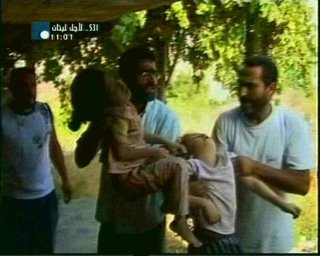 In this second war, the shock troops are the journalists, photographers and television crews. They supply the raw material - the bullets, if you like - which shape opinions and give substance to the debate. We cannot all be there ourselves, so we rely on that information. We need it because we are not there, because we haven't smelled the death and the terror, because we have not seen the corpses with our own eyes. But, since this is the material that will shape our opinions and, through us the opinions of our politicians, we are entitled to ask whether it is accurate and unbiased. That we are not there does not disbar us from asking - it makes the asking all that more necessary.
In this second war, the shock troops are the journalists, photographers and television crews. They supply the raw material - the bullets, if you like - which shape opinions and give substance to the debate. We cannot all be there ourselves, so we rely on that information. We need it because we are not there, because we haven't smelled the death and the terror, because we have not seen the corpses with our own eyes. But, since this is the material that will shape our opinions and, through us the opinions of our politicians, we are entitled to ask whether it is accurate and unbiased. That we are not there does not disbar us from asking - it makes the asking all that more necessary.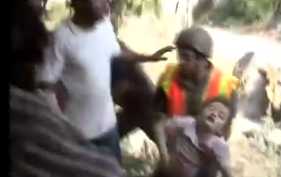 And in this war, this second war, we have been offered the iconic figure of "Green Helmet" who, a number of our readers suggest, is Abu Shadi Jradi. His pain as he carries the body of a dead girl sums up the outrage of the Qana incident and conveys to us the horror of a war which all good people want to end. We are being asked to share that pain and, overtly in many cases, to condemn those whom we are told caused it.
And in this war, this second war, we have been offered the iconic figure of "Green Helmet" who, a number of our readers suggest, is Abu Shadi Jradi. His pain as he carries the body of a dead girl sums up the outrage of the Qana incident and conveys to us the horror of a war which all good people want to end. We are being asked to share that pain and, overtly in many cases, to condemn those whom we are told caused it.But we, in turn, are entitled to know whether that "pain" is real and even if it is, whether it is being used to manipulate our thinking and turn our sentiment one way or another. On the other hand, no one is entitled to demand our uncritical acceptance of that which we are shown - that we should necessarily and always accept it as the unvanrished truth.
It is in this context that we are asking: "what is the truth"? We ask it because we have done something we were not supposed to do... we have put all the separate photographs that we can find of one sequence of events. And they simply do not stack up. Some we have shown before, some are new to this blog, and the sequence starts with the first three photographs above. These purportedly show the recovery of the body of a girl from the wreckage of the building in Qana, prior to its transmission to a waiting ambulance.
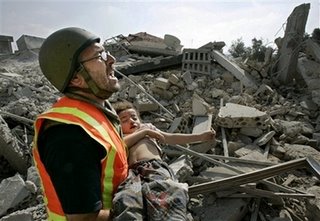 Sometime in between the wreckage and the ambulance, however, we get the iconic picture, the one that has been reproduced in newspapers thoughout the world. This one, we can see, is near the wreckage of the building but, was it posed? We do not know but, in viewing hours of video footage, we have not yet seen the scenario filmed. That, in itself is possibily noteworthy, given the number of TV cameras that were around. Virtually everything on the scene was being filmed - yet no-one seems to have filmed this.
Sometime in between the wreckage and the ambulance, however, we get the iconic picture, the one that has been reproduced in newspapers thoughout the world. This one, we can see, is near the wreckage of the building but, was it posed? We do not know but, in viewing hours of video footage, we have not yet seen the scenario filmed. That, in itself is possibily noteworthy, given the number of TV cameras that were around. Virtually everything on the scene was being filmed - yet no-one seems to have filmed this.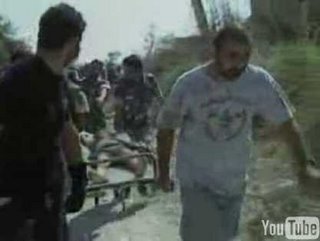 What we do see on the videos are harrowing scenes of bodies being laid outside the building and others being brought out and handed to first aid and other workers, who then convey them to the ambulances or other vehicles. There seems to be a relatively well-organised division of labour, where the rescue workers recover the bodies and then hand them on outside the building for transportation.
What we do see on the videos are harrowing scenes of bodies being laid outside the building and others being brought out and handed to first aid and other workers, who then convey them to the ambulances or other vehicles. There seems to be a relatively well-organised division of labour, where the rescue workers recover the bodies and then hand them on outside the building for transportation. This might be what is happening here. "Green Helmet" is carrying the girl's body, still within sight of the wreckage, running towards a Red Cross worker. It looks as if he is about to hand over the body - it certainly looks like it, and the receiver has his arms out as if to take the load. But it could be that the Red Cross worker is simply directing "Green Helmet" to a waiting stretcher, or some other location.
This might be what is happening here. "Green Helmet" is carrying the girl's body, still within sight of the wreckage, running towards a Red Cross worker. It looks as if he is about to hand over the body - it certainly looks like it, and the receiver has his arms out as if to take the load. But it could be that the Red Cross worker is simply directing "Green Helmet" to a waiting stretcher, or some other location. Anyhow, we do not see the outcome of this scene, but what we are shown is a transfer to the hands of another worker and the body being placed on a "guerney". This is still in sight of the debris so we know it must be in close proximity to the collapsed building. We can see that it is at the bottom of the mound of debris, on a relatively flat surface and it is likely that the "gurney" itself has been wheeled to the position.
Anyhow, we do not see the outcome of this scene, but what we are shown is a transfer to the hands of another worker and the body being placed on a "guerney". This is still in sight of the debris so we know it must be in close proximity to the collapsed building. We can see that it is at the bottom of the mound of debris, on a relatively flat surface and it is likely that the "gurney" itself has been wheeled to the position. By reference to a new (to us) photograph, we see that this transfer did take place on film, but the "gurney" is used to transport the bodies of two victims, the other also the body of a girl, which looks rather like that transported by the man we call "White Tee-shirt". So far, so good. The next stop, logically, is the ambulance. There could be no other reason for loading the bodies on the gurney.
By reference to a new (to us) photograph, we see that this transfer did take place on film, but the "gurney" is used to transport the bodies of two victims, the other also the body of a girl, which looks rather like that transported by the man we call "White Tee-shirt". So far, so good. The next stop, logically, is the ambulance. There could be no other reason for loading the bodies on the gurney. What then do we make of this photograph? "Green Helmet" is carrying the girl's body but we have no reference point and there is no sign of debris. It could be anywhere in the vicinity of the building - but it is unlikely to be that close. The area seems relatively flat and, to the bottom-left of the picture is a glimpse of a smooth, debris-free path. Where does this photograph fit into the overall sequence? Why is "Green Helmet" still carrying the body?
What then do we make of this photograph? "Green Helmet" is carrying the girl's body but we have no reference point and there is no sign of debris. It could be anywhere in the vicinity of the building - but it is unlikely to be that close. The area seems relatively flat and, to the bottom-left of the picture is a glimpse of a smooth, debris-free path. Where does this photograph fit into the overall sequence? Why is "Green Helmet" still carrying the body? And if the above photograph might be anomalous, what about this one? The wrecked bulding is nowhere in sight - there is no debris and the picture shows a wide street. Again, there is no reference point - by which we can measure the distance to the collapsed building, so it is not possible to judge where we are relative to it. There is, however, no sign of an ambulance or other vehicle, and no other workers. Once again, therefore, why is "Green Helmet" carrying the body, why is he on his own, and how does this picture fit into the sequence?
And if the above photograph might be anomalous, what about this one? The wrecked bulding is nowhere in sight - there is no debris and the picture shows a wide street. Again, there is no reference point - by which we can measure the distance to the collapsed building, so it is not possible to judge where we are relative to it. There is, however, no sign of an ambulance or other vehicle, and no other workers. Once again, therefore, why is "Green Helmet" carrying the body, why is he on his own, and how does this picture fit into the sequence? To add to the puzzle, though, we see this. The man is, as far as I can tell, "Green Helmet". But gone is the helmet, the fluorescent waistcoat, the radio and the flack jacket. And he is carrying the girl's body, with no sign of the gurney or the "man in black" who was in charge of it. What is happening here? Is this really consistent with the other photographs?
To add to the puzzle, though, we see this. The man is, as far as I can tell, "Green Helmet". But gone is the helmet, the fluorescent waistcoat, the radio and the flack jacket. And he is carrying the girl's body, with no sign of the gurney or the "man in black" who was in charge of it. What is happening here? Is this really consistent with the other photographs?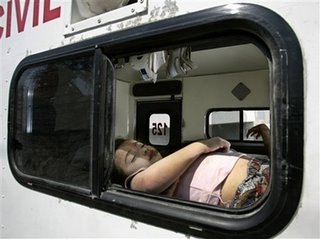 Now we see the girl's body in the ambulance. There have been some perfectly sound questions about our reliance on the datelines offered by the agencies so we will not rely on the timing. We do not know for certain whether this picture was taken before or after the others. We can assume this is the last in the sequence - that would be a logical assumption, but still an assumption. We do not see the doors closed and the vehicle drive off.
Now we see the girl's body in the ambulance. There have been some perfectly sound questions about our reliance on the datelines offered by the agencies so we will not rely on the timing. We do not know for certain whether this picture was taken before or after the others. We can assume this is the last in the sequence - that would be a logical assumption, but still an assumption. We do not see the doors closed and the vehicle drive off.Nothing here is conclusive evidence of the shots being posed. I think it is fair to say, however, that there are unanswered questions and good reason for suspicion - and this is but one sequence. We will also look in more detail at the others.
COMMENT THREAD
No comments:
Post a Comment
Note: only a member of this blog may post a comment.